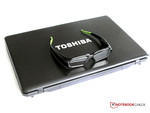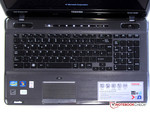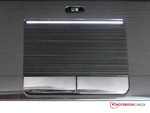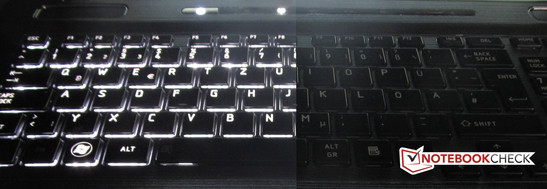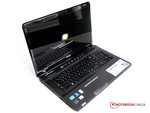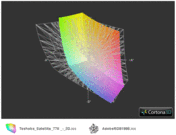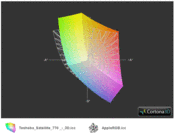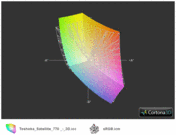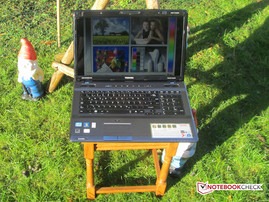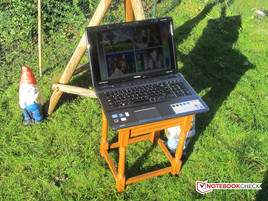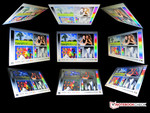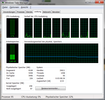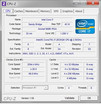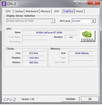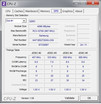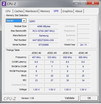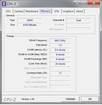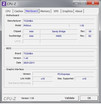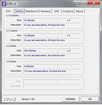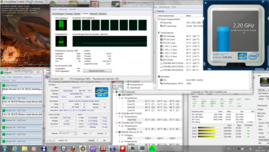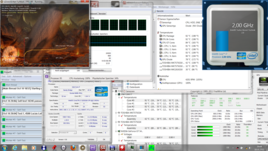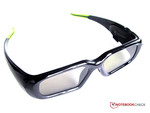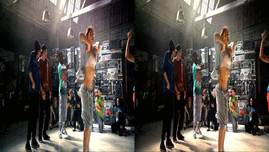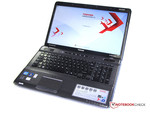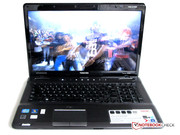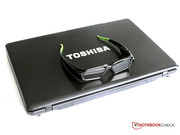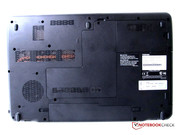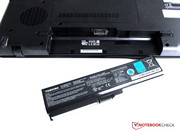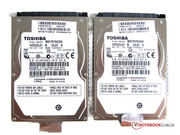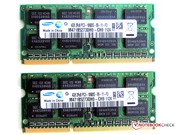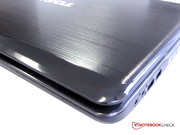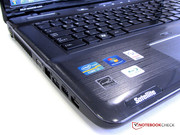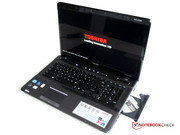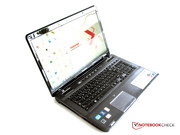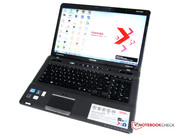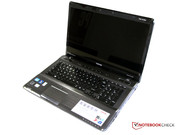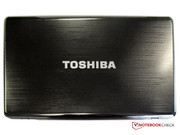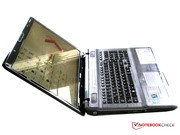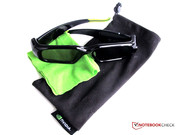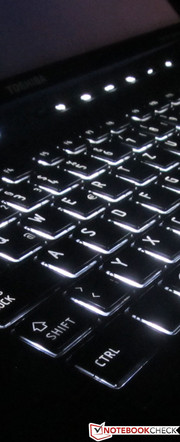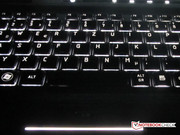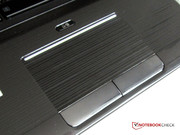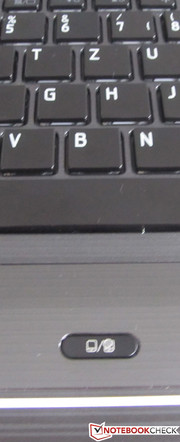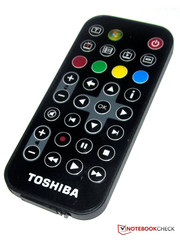Review Toshiba Satellite P775-100 3D-Vision Notebook

Not only has 3D been on the rise in cinemas in the last few years, but also at home. That was also confirmed at the last IFA in Berlin. Be it on the TV or on the go with the notebook; the trend even goes in the direction that no special 3D glasses are needed to view of 3D material (video, images, or games).
The 3D notebook, Satellite P775-100 3D Vision, still opts for shutter glasses technology. This means that 3D entertainment can only be seen with glasses. The two images are displayed on the screen with a slight time shift for the left and for the right eye. The image looks very blurred without these glasses. First the shutter glasses, which run synchronous to the single images, makes it to a three dimensional picture. A feature of this Toshiba model is that it usually only needs a touch of a button to convert a 2D image to 3D material. The Toshiba Satellite P775-100 3D Vision comes with a pair of Nvidia shutter glasses.
The Toshiba 3D laptop is in a familiar case from the Satellite range. The 17.3 inch screen has a Full HD resolution (1920x1080), but with a glossy surface. Toshiba has installed a Core i7-2630QM (quad core) and Nvidia Geforce GT 540M inside. It also has two hard disks with 750 GB each and a RAM of 8 GB. Rather than a DVD burner, a Blu-Ray drive is found in the laptop (burning DVDs possible).
This configuration of the Satellite P775-100 3D Vision from Toshiba is sold for about 1500€ (including VAT).
Case
This model has also inherited the peculiarities of the case used in the entire Satellite range. In terms of material, Toshiba completely relies on plastic and that is noticed when it's touched for the first time at the very latest. The surfaces have a pleasant feel, but yield quickly under light pressure.
Overall, the case has a satisfactory, but not good pressure stability. The wrist rest yields on the outer right and left under the weight of the hands. The optical drive is, as so often, a weak point. Although the number pad above it can't be depressed, the base plate below it can.
The display lid is kept in place by two hinges, which have a good hold. The frame hardly teeters after it's opened. The maximum opening angle of about 140 degrees is well suited for use on the lap. The display bezel of the 17.3 inch screen is easy to warp and can also be pressed on the back. The display bezel "rattles" on the base unit in a closed state because it lacks a lock hook or similar mechanisms.
The notebook's black surface magically attracts dust, but it doesn't prove to be as prone to fingerprints.
The Satellite P775-100 3D Vision weighs proud 3.15 kg, including the 6 cell battery. The power adapter adds another 650 grams. The notebook's outer dimensions are 270 x 413 x 28 mm (front). The rear has a height of up to 36 mm.
Connectivity
Many interfaces are distributed around the laptop. In addition to four USB ports, one of which supports USB 3.0, there is a VGA and HDMI port, two audio jacks (1 headphone, 1 microphone) and the RJ45 jack.
The optical drive - a Blu-Ray reader - is built-in on the right. The card reader for SD/MMC and MS memory cards is located on the front.
The rear remains exempt from interfaces and sockets in this notebook. There is no connector for a docking station on the laptop's bottom.
A point of complaint: All ports on the sides are in the front area. Disturbing cables and plugs beside the laptop have to be reckoned with when they are used extensively.
Communication
Toshiba uses the standard options for connectivity: The Satellite notebook can connect to a Gigabit network via network cable. The Realtek controller is compatible with 10/100/1000 Mbit. The Atheros wireless adapter (AR9002WB-1NG) supports the standard IEEE 802.11 b/g/n. The notebook bids Bluetooth 3.0 +HS as a third option.
Security
The P775-100 doesn't have many security features. In terms of hardware, there is a preparation for a security lock (Kensington) on the case. And that was it. This model doesn't have a fingerprint scanner or biometric face detection.
However, the system can be password protected; by a user password or a supervisor password. The hard disk can also be password protected.
Supplies
Besides the notebook and the charger, Nvidia's 3D Vision Kit, which contains the shutter glasses, a storage case, a cleaning cloth and an adjustable centerpiece, is in the box. There is also a small Windows Media Center remote control.
Software
In addition to the Windows 7 Home Premium operating system (64 bit with SP1), the following programs are pre-installed on the Toshiba notebook: Toshiba Disc Creator, Toshiba Value Added Package (Toshiba Power Saver, Toshiba Zooming Utility, Toshiba PC Diagnostic Tool, Toshiba Flash Cards, Toshiba Components Common Driver, Toshiba Accessibility, Toshiba Button Support), McAfee Internet Security (30 day Internet update), WildTangent Gaming Console, Toshiba Photo Service, Toshiba Recovery Media Creator, WinDVD BD, Nero BackItUp & Burn auto-backup Essentials, Microsoft Word and Excel (with ads and limited functionality), Toshiba Video Player, Nero Multimedia Suite 10 Essential, Toshiba Music Place, CorelDigital Studio.
Warranty
This model has a warranty period of 24 months, including a 2 year international bring-in manufacturer warranty (Europe, Middle East, Africa) and an onsite pick-up service in Germany and Austria (repair has to be registered via Toshiba Notebook Hotline). The manufacturer also sells a warranty extension of up to 3 or 4 years (for 64, respectively 109€).
Input Devices
Keyboard
The keyboard, comprised of 102 keys, including a separate number pad, hasn't been modified in comparison to other Satellite models (P770-10P). Toshiba relies on the tried and tested here. If the user prefers, a backlight can be turned on and can also be disabled via a timer. Every key has its own LED. We notice that the fairly long space bar is only illuminated on the left. This is either Toshiba's intention, or an LED was already malfunctioning in our test model.
Toshiba has placed seven additional function keys above the keyboard. They light up when touched. Three of the keys enable or disable WLAN, the 3D functionality, or start the Web browser. The other keys control the volume, or are "start" and "pause" buttons for the video player.
Touchpad
The touchpad is located in front of the keyboard. As already in the P770-10P it is capable of multi-touch and supports gesture navigation (scroll, zoom). The touchpad can be disabled via a dedicated button.
Webcam
The two webcams installed into the display bezel (with built-in microphone) support a resolution of 1280x800 and can also be used as a 3D camera.
Display
Toshiba uses a 17.3 inch, glossy Trubrite FHD screen (43.9 cm) in the P775-100 3D Vision notebook. It has an LED backlight The screen can reproduce a maximum resolution of 1920x1080 pixels (Full HD) in an aspect ratio of 16:9. Additional monitors/displays can be connected to the laptop over the lateral VGA socket or HDMI port. They allow a maximum resolution of up to 2048x1536 pixels.
| |||||||||||||||||||||||||
Brightness Distribution: 80 %
Center on Battery: 181 cd/m²
Contrast: 696:1 (Black: 0.26 cd/m²)
66.2% AdobeRGB 1998 (Argyll 3D)
90% sRGB (Argyll 3D)
68.4% Display P3 (Argyll 3D)
| |||||||||||||||||||||||||
Brightness Distribution: 79 %
Center on Battery: 362 cd/m²
Contrast: 566:1 (Black: 0.64 cd/m²)
66.2% AdobeRGB 1998 (Argyll 3D)
90% sRGB (Argyll 3D)
68.4% Display P3 (Argyll 3D)
The measurements of the FHD screen recorded a contrast of 696:1 at a black value of 0.26 cd/m2 and an illumination of 80 percent. The maximum brightness of only 189 cd/m2 isn't convincing.
The comparisons of the reproducible color spectrum show an almost complete coverage of sRGB. Consequently, the used screen is above the current average.
Not much of the color brilliance - which was already moderate indoors - was left over outdoors due to the screen's limited brightness. The reflections of the environment contributed even more to this. Little could be seen on the high-gloss screen depending on the viewing angle. Even the glossy display bezel reflected a lot.
The FHD screen's viewing angles in this Toshiba laptop aren't particularly wide especially on the vertical plane. The displayed content starts to distort at a tilt angle (back and forth) of approximately 45 degrees. It fades, respectively inverts so that we couldn't recognize much of the displayed content in these positions.
When the display is at a 90 degree angle to the base unit, the content can be recognized well from both the front and sides. The colors are strong and rich in contrast on the 17 inch device, depending on the lighting conditions (in dark rooms).
Performance
A 2.0 GHz Core i7-2630QM is used as the processor. This CPU has four cores and supports Hyper Threading (8 threads). Single cores of the CPU can be overclocked up to 2.9 GHz via Turbo Boost 2.0 when required and with sufficient cooling. The quad core processor is based on the current Sandy Bridge architecture (with 32 nm manufacturing technology, 995 million transistors on one DIE size of 216 mm2).
Intel has also embedded a DirectX 10 capable Intel HD Graphics 3000 chip and the DDR3-1066/1333 memory controller (max. 8GB) on the quad core CPU's DIE.
The NVIDIA Geforce GT 540M graphics is automatically enabled or disabled via Nvidia's Optimus.
We check for possible latency problems, which could emerge due to synchronization errors with external hardware at the interfaces, with the program, DPC Latency Checker.
All measurements were in the green area, as can be seen on the screenshot. This means that restrictions, particularly in the audio or video field, aren't to be expected.
How well the Satellite P775-100 fares in the CPU benchmarks is best shown in a direct comparison with the almost identically built model, the P770-10P (i7-2630QM/GT 540M):
The results of 4.51 points (CPU) and 24.99 fps (OpenGL) are on a par with the Toshiba P770-10P (4.72/24.99) or the Schenker XMG A701 Advanced notebook (4.57/25.04) in Cinebench R11.5. It also looks similar in Cinebench R10 Rendering.
In the latest model (P775-100), PCMark Vantage finishes with 6519. This result is clearly in the lower field of our database and 444 points (~8%) behind the Toshiba P770-10P. The Schenker notebook, XMG A701 Advanced (17"), even managed a score of 14285 with the same CPU/graphics. However, the installed SSD drive contributes significantly to the Schenker notebook's good score.
The PCMark 7 result is only mediocre with 2024 points. The Toshiba P770-10P achieved 2688 points (+25%) here.
» No benchmarks for this notebook found!
» No benchmarks for this notebook found!
» No benchmarks for this notebook found!
Two graphic cards do their job in the Toshiba P775-100. One is the Core i7 CPU embedded HD Graphics 3000 and the other is a dedicated Nvidia graphics card, model Geforce GT 540M. While the embedded graphics doesn't have its own video memory, the Nvidia graphics can fall back on 2048 MB. Depending on the application and power consumption (battery or outlet), either the Intel or the Nvidia graphics is enabled automatically. Nvidia Optimus switches the GPU without making it necessary to reboot the laptop. Single programs can also be assigned to the Intel or the Nvidia graphics manually via the Nvidia control panel.
The Nvidia graphics always has to be used in full screen mode during 3D mode. The Intel graphic's power reserves wouldn't suffice for these 3D calculations.
The determined rates in the Futuremark benchmarks are slightly below the expected level. We can only record a score of 978 points in 3DMark 11. In comparison: The 3DMark 11 score was 1033 points in the Sony Vaio VPC-F21Z1E/BI, which also has an i7.2630QM and the same graphics. The Toshiba P770-10P managed 1009 points here. The scores are similar in 3DMark 06. The P775-100 always scores a bit lower on average than the almost identically built P770-10P from Toshiba.
» No benchmarks for this notebook found!
Stress Test
We can't determine anything negative in the Intel quad core in our simulated stress test. The processor's clock rate was around 2.9 GHz in the beginning, but settled to about 2 GHz in the course of the 90 minute stress test. The Core i7-2630QM's base clock was never exceeded, though.
HDD Performance
There are two hard disks in the Toshiba notebook, but they are only set up as a single drive. Both disks come from Toshiba, have a (gross) capacity of 750 GB each and originate from the MK7575GSX series that rotates with 5400 revolutions per minute.
It's not possible to enable a RAID mode due to the lacking support. Both Serial ATA hard disks are pretty fast and achieve a burst rate of about 125 MB/s. The access times are 17 ms.
The transfer rate of averagely 85 MB/s is quite good. But it could certainly be higher in a RAID array. Too bad that Toshiba doesn't use a corresponding RAID controller.
Gaming Verdict
We only tried out how games behave with the GT 540M in random tests because comprehensive gaming tests have previously been made with this GPU. More information about these can be found in our data sheet of the GT 540M. That also applies to gaming with the quad core CPU incorporated HD Graphics 3000.
The scores assessed with the P775 in the games Dirt 3, Mafia II or FIFA 11 approximately correspond to the previous rates found in our comprehensive database.
3D Vision
We also wanted to know what 3D playability looks like. Switching to 3D is easily accomplished by pressing a button on the Toshiba Satellite P775-100 3D Vision, providing the stereoscopic 3D function is enabled in the control panel.
The stereoscopic 3D feature is disabled or enabled over Nvidia's control panel of the video card. The 3D effect's strength can be customized via a slider.
The overlapping images can be assigned to the according eye with the shutter glasses, which is included in the laptop's scope of delivery. The pictures are seen at the same time and the image looks very blurred without the glasses.
A button on the soft touch bar remedies this. Pressing this button converts the image from 3D to 2D or vice versa.
While the frames per second (fps) were still fairly good in our test games, the fps nosedived here. For example, where we still measured over 53 fps in Mafia II in the resolution low, the rate decreased to 20 fps in 3D mode. In Drift 3 or FIFA 11, the frame rates were halved in all selected resolutions.
Depending on the resolution, stuttering became obvious and the game first ran smoothly again in a low resolution and fewer details. Dirt 3 first ran smoothly in an 800 resolution and 3D. The game was unplayable in Full HD and 3D. FIFA 11 isn't quite as sensitive. 20 frames rather than 40 frames were recorded in Full HD mode (1920x1080). 30 rather than 60 frames were given in the 1300 resolution. Fraps (test software for determining frame rates) showed 90 frames in 3D with the 800 resolution.
Even older games run on the video card's stereoscopic 3D function in the third dimension.
The Toshiba P775-100 can also benefit from the current trend of filming single blockbusters in 3D. The according movies can be played without problems via the built-in Blu-Ray drive. Even movie trailers from the Internet run in 3D when the corresponding parameters are available. A few 3D movie trailers are included on the notebook in its state of delivery. They show how such movies could look like on the laptop.
The 3D movies can also be watched without the 3D glasses, but only in 2D. Only a few settings in the player are needed. The right or left image is omitted then.
Emissions
System Noise
Although the system fan is permanently active in the P775-100 notebook, it wasn't noticed adversely in the various noise assessments. We could only measure a rate of 40.1 dB (A) at a distance of 15 cm during load.
The rates were between 34.8 and 35.1 dB (A) in idle mode. The noise also only increased to 38.2 dB (A) during DVD playback. The noise quickly died off in the room and was inaudible at a distance of good 1.5 meters.
Temperature
The Toshiba P775-100 3D Vision behaves well in idle or simple office use and only selectively exceeds 30 degrees (bottom). The maximum temperature on the top is about 1 degree less. The average rates achieved 26.9 (top) and 27.2 degrees (bottom).
The waste heat peaks were considerably higher in the stress test: We could measure 51 degrees Celsius in the vent's area on the bottom. It was only 24.1 degrees Celsius on the opposite side. The average rates were 36.6 degrees (bottom) and 36.4 degrees (top).
The wrist rest achieved a temperature of up to 41.4 degrees in the stress test, which can also be felt without a thermometer. The laterally discharged power dissipation also feels a lot warmer, especially when the notebook is placed on the lap.
The adapter reached a maximum temperature of 44 degrees.
(-) The maximum temperature on the upper side is 47.1 °C / 117 F, compared to the average of 36.4 °C / 98 F, ranging from 24.7 to 57 °C for the class .
(-) The bottom heats up to a maximum of 51.7 °C / 125 F, compared to the average of 37.7 °C / 100 F
(+) In idle usage, the average temperature for the upper side is 26.9 °C / 80 F, compared to the device average of 31.5 °C / 89 F.
(-) The palmrests and touchpad can get very hot to the touch with a maximum of 41.4 °C / 106.5 F.
(-) The average temperature of the palmrest area of similar devices was 29.4 °C / 84.9 F (-12 °C / -21.6 F).
Speakers
Two speakers take care of the sound. They are located above the keyboard in the Satellite notebook. The two speakers from Harman/Kardon emit a good sound, although the device doesn't have a subwoofer. The sound can be improved even more via the Dolby Audio Enhancer and modified to suit personal preferences. The volume can be easily controlled or muted via the soft touch bar (above the keyboard). However, the keys' beep sound is irritating when they are triggered. This can't be disabled.
Battery Life
The Satellite P775-100's power consumption is about equal to the P770 model. The more power is needed, the higher the power consumption. In idle, where all saving options are enabled (minimum display brightness, disabled wireless modules), the power consumption is 16.5 watts. 21.9 watts are consumed with a bright display, enabled WLAN and energy settings on high performance.
The maximum measured power consumption of the laptop (stress test) is 94 watts. The 120 watt adapter (about 650 grams) is sufficiently sized for this.
The included 48 watt battery is based on a lithium ion technology and allows the P775-100 notebook work independent of an external power source. The question is - for how long? Our processor stress test drains the battery's power after a relatively short time. The laptop shuts down after only 48 minutes. Recharged within two hours, we could watch a DVD movie for exactly 53 minutes. After this time, the screen turned black and the notebook turned itself off. Recharged again, we surfed on the Internet via WLAN. The battery lasted for 121 minutes here. We measured 164 minutes (~2:44h) in the Reader's Test where WLAN is disabled and the display brightness is set to minimum.
Those are fairly short runtimes, but perhaps the energy profiles that Toshiba includes on the laptop will help here. We even recorded a shorter battery runtime in eco mode with the Reader's Test. Rather than the previously measured 164 minutes, it is now only 131 minutes. Taking matters into our own hands apparently has a greater effect than the manufacturer's defaults.
Verdict
Pretty notebook with 3D features, but we ask ourselves why glasses are still needed. Toshiba proved that this is also possible without even before the IFA. The P775-100 3D Vision is almost based completely on the model, P770-10P (without 3D functions) - including all pros and cons. Toshiba has copied the case, its interfaces and functions 1:1. Even the cheap looking plastic material. We would have expected more from a 17.3 inch notebook priced at about 1500€.
The built-in hardware hasn't changed, with exception of the two hard disks and memory unit. The hard disk's capacity has increased to 1.5 terabyte and the RAM is now 8 GB. That is the least that could be expected in view of a price difference of ~500€ compared to the P770-10P. A quad core (Core i7-2630QM) and an Nvidia graphics (GT 540M) supplies enough power in the current model, but only in 2D mode.
The P770 model didn't have 3D. A pair of shutter glasses is included in the scope of delivery and makes watching movies and games in the third dimension possible. 2D material can also be viewed on the Satellite P775-100 in 3D. 3D movies run smoothly. But principally, a matt and considerably brighter screen would have been better.
Within games, the frame rate nosedives by almost 50 percent when switched from 2D to 3D. Thus, stuttering has to be expected in some games and only a significant reduction of graphic details helps. Another feature in the Satellite P775-100 is the installed DVB-T receiver, but the matching antenna isn't included.
1500€ for a 3D laptop in a plastic case is a lot of money, especially since the graphics performance is only on a midrange standard. And the display doesn't belong to the best of its kind, either.




